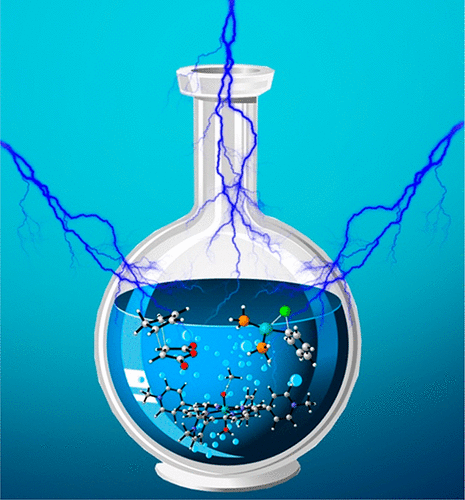当前位置:
X-MOL 学术
›
J. Am. Chem. Soc.
›
论文详情
Our official English website, www.x-mol.net, welcomes your
feedback! (Note: you will need to create a separate account there.)
Electric-field mediated chemistry: uncovering and exploiting the potential of (oriented) electric fields to exert chemical catalysis and reaction control
Journal of the American Chemical Society ( IF 14.4 ) Pub Date : 2020-06-18 , DOI: 10.1021/jacs.0c05128 Sason Shaik 1 , David Danovich 1 , Jyothish Joy 1 , Zhanfeng Wang 1 , Thijs Stuyver 1, 2
Journal of the American Chemical Society ( IF 14.4 ) Pub Date : 2020-06-18 , DOI: 10.1021/jacs.0c05128 Sason Shaik 1 , David Danovich 1 , Jyothish Joy 1 , Zhanfeng Wang 1 , Thijs Stuyver 1, 2
Affiliation

|
This Perspective discusses oriented external-electric-fields (OEEF), and other electric-field types, as 'smart reagents', which enable in principle control over wide-ranging aspects of reactivity and structure. We discuss the potential of OEEFs to control non-redox reactions and impart rate-enhancement and selectivity. An OEEF along the 'reaction-axis', which is the direction whereby electronic reorganization converts reactants' to products' bonding, will accelerate reactions, control regioselectivity, induce spin-state selectivity, and elicit mechanistic-crossovers. Simply flipping the direction of the OEEF will lead to inhibition. Orienting the OEEF off the reaction-axis enables control over stereoselectivity, enantioselectivity, and product-selectivity. For polar/polarizable reactants, the OEEF itself will act as tweezers, which orient the reactants and drive their reaction. OEEFs also affect bond-dissociation energies and dissociation-modes (covalent vs. ionic), as well as alteration of molecular geometries and supramolecular aggregation. The 'key' to gaining access to this toolbox provided by OEEFs is microscopic control over the alignment between the molecule and the applied field. We discuss the elegant experimental methods which have been used to verify the theoretical predictions, and describe various alternative EEF sources and prospects for upscaling OEEF catalysis in solvents. We also demonstrate the numerous ways in which the OEEF effects can be mimicked by use of (designed) local-electric fields (LEFs), i.e. by embedding charges or dipoles into molecules. LEFs and OEEFs are shown to be equivalent and to obey the same ground rules. Outcomes are exemplified for Diels-Alder cycloadditions, oxidative-addition of bonds by transition-metal complexes, H-abstractions by oxo-metal species, ionic cleavage of halogen-bonds, methane activation, etc.
中文翻译:

电场介导的化学:揭示和利用(定向)电场的潜力来发挥化学催化和反应控制
本视角讨论了定向外电场 (OEEF) 和其他电场类型,作为“智能试剂”,它们原则上能够控制反应性和结构的广泛方面。我们讨论了 OEEF 在控制非氧化还原反应和提高速率和选择性方面的潜力。沿着“反应轴”的 OEEF,即电子重组将反应物转化为产物键的方向,将加速反应,控制区域选择性,诱导自旋状态选择性,并引发机械交叉。简单地改变 OEEF 的方向会导致抑制。将 OEEF 偏离反应轴可以控制立体选择性、对映选择性和产物选择性。对于极性/可极化反应物,OEEF 本身将充当镊子,用于定向反应物并驱动它们的反应。OEEF 还影响键解离能和解离模式(共价与离子),以及分子几何形状和超分子聚集的改变。访问 OEEF 提供的这个工具箱的“关键”是对分子和应用场之间对齐的微观控制。我们讨论了用于验证理论预测的优雅实验方法,并描述了各种替代 EEF 来源和在溶剂中升级 OEEF 催化的前景。我们还展示了通过使用(设计的)局部电场 (LEF),即通过将电荷或偶极子嵌入分子中来模拟 OEEF 效应的多种方式。LEF 和 OEEF 显示为等效并遵守相同的基本规则。结果举例说明了 Diels-Alder 环加成、过渡金属配合物的键氧化加成、氧合金属物种的 H-抽象、卤素键的离子裂解、甲烷活化等。
更新日期:2020-06-18
中文翻译:

电场介导的化学:揭示和利用(定向)电场的潜力来发挥化学催化和反应控制
本视角讨论了定向外电场 (OEEF) 和其他电场类型,作为“智能试剂”,它们原则上能够控制反应性和结构的广泛方面。我们讨论了 OEEF 在控制非氧化还原反应和提高速率和选择性方面的潜力。沿着“反应轴”的 OEEF,即电子重组将反应物转化为产物键的方向,将加速反应,控制区域选择性,诱导自旋状态选择性,并引发机械交叉。简单地改变 OEEF 的方向会导致抑制。将 OEEF 偏离反应轴可以控制立体选择性、对映选择性和产物选择性。对于极性/可极化反应物,OEEF 本身将充当镊子,用于定向反应物并驱动它们的反应。OEEF 还影响键解离能和解离模式(共价与离子),以及分子几何形状和超分子聚集的改变。访问 OEEF 提供的这个工具箱的“关键”是对分子和应用场之间对齐的微观控制。我们讨论了用于验证理论预测的优雅实验方法,并描述了各种替代 EEF 来源和在溶剂中升级 OEEF 催化的前景。我们还展示了通过使用(设计的)局部电场 (LEF),即通过将电荷或偶极子嵌入分子中来模拟 OEEF 效应的多种方式。LEF 和 OEEF 显示为等效并遵守相同的基本规则。结果举例说明了 Diels-Alder 环加成、过渡金属配合物的键氧化加成、氧合金属物种的 H-抽象、卤素键的离子裂解、甲烷活化等。









































 京公网安备 11010802027423号
京公网安备 11010802027423号